Diversity and Distribution Characteristics of Soil Microbes across Forest–Peatland Ecotones in the Permafrost Regions
Abstract
:1. Introduction
2. Materials and Methods
2.1. Study Area
2.2. Soil Collection and Experimental Design
2.3. Physicochemical Parameter Measurements
2.4. DNA Extraction, PCR Amplification, and Illumina Sequencing
2.5. Data Processing
3. Results
3.1. Soil Physicochemical Characteristics
3.2. Richness and Diversity of the Soil Bacterial Community
3.3. Composition and Structure of the Soil Bacterial Community
3.4. Functional Metabolic Pathways
3.5. Relationship between Environmental Properties and Soil Bacterial Communities
4. Discussion
5. Conclusions
Author Contributions
Funding
Institutional Review Board Statement
Informed Consent Statement
Data Availability Statement
Conflicts of Interest
References
- Jansson, J.K.; Taş, N. The microbial ecology of permafrost. Nat. Rev. Microbiol. 2014, 12, 414–425. [Google Scholar] [CrossRef]
- Pastukhov, A.V.; Kaverin, D.A. Ecological state of peat plateaus in northeastern European Russia. Russ. J. Ecol. 2016, 47, 125–132. [Google Scholar] [CrossRef]
- Du, R.; Peng, X.Q.; Frauenfeld, O.W.; Sun, W.; Liang, B.B.; Chen, C.; Jin, H.D.; Zhao, Y.H. The role of peat on permafrost thaw based on field observations. Catena 2022, 208, 105772. [Google Scholar] [CrossRef]
- Kluber, L.A.; Johnston, E.R.; Allen, S.A.; Hendershot, J.N.; Hanson, P.J.; Schadt, C.W. Constraints on microbial communities, decomposition and methane production in deep peat deposits. PLoS ONE 2020, 15, e0223744. [Google Scholar] [CrossRef] [Green Version]
- Sim, T.G.; Swindles, G.T.; Morris, P.J.; Baird, A.J.; Cooper, C.L.; Gallego-Sala, A.V.; Charman, D.J.; Roland, T.P.; Borken, W.; Mullan, D.J.; et al. Divergent responses of permafrost peatlands to recent climate change. Environ. Res. Lett. 2021, 16, 034001. [Google Scholar] [CrossRef]
- Turetsky, M.R.; Wieder, R.K.; Vitt, D.H.; Evans, R.J.; Scott, K.D. The disappearance of relict permafrost in boreal north America: Effects on peatland carbon storage and fluxes. Glob. Chang. Biol. 2007, 13, 1922–1934. [Google Scholar] [CrossRef]
- Naylor, D.; McClure, R.; Jansson, J. Trends in Microbial Community Composition and Function by Soil Depth. Microorganisms 2022, 10, 540. [Google Scholar] [CrossRef]
- Andersen, R.; Chapman, S.J.; Artz, R.R.E. Microbial communities in natural and disturbed peatlands: A review. Soil Biol. Biochem. 2013, 57, 979–994. [Google Scholar] [CrossRef]
- Swindles, G.T.; Morris, P.J.; Mullan, D.; Watson, E.J.; Turner, T.E.; Roland, T.P.; Amesbury, M.J.; Kokfelt, U.; Schoning, K.; Pratte, S.; et al. The long-term fate of permafrost peatlands under rapid climate warming. Sci. Rep. 2015, 5, 17951. [Google Scholar] [CrossRef] [Green Version]
- Dimitrov, D.D.; Bhatti, J.S.; Grant, R.F. The transition zones (ecotone) between boreal forests and peatlands: Ecological controls on ecosystem productivity along a transition zone between upland black spruce forest and a poor forested fen in central Saskatchewan. Ecol. Model. 2014, 291, 96–108. [Google Scholar] [CrossRef]
- Briones, M.J.I.; Juan-Ovejero, R.; McNamara, N.P.; Ostle, N.J. Microbial “hotspots” of organic matter decomposition in temperate peatlands are driven by local spatial heterogeneity in abiotic conditions and not by vegetation structure. Soil Biol. Biochem. 2022, 165, 108501. [Google Scholar] [CrossRef]
- Wu, X.W.; Zang, S.Y.; Ma, D.L.; Ren, J.H.; Chen, Q.; Dong, X.F. Emissions of CO2, CH4, and N2O Fluxes from Forest Soil in Permafrost Region of Daxing’an Mountains, Northeast China. Int. J. Env. Res. Public Health 2019, 16, 2999. [Google Scholar] [CrossRef] [Green Version]
- Laine, A.M.; Mehtätalo, L.; Tolvanen, A.; Frolking, S.; Tuittila, E.-S. Impacts of drainage, restoration and warming on boreal wetland greenhouse gas fluxes. Sci. Total Environ. 2019, 647, 169–181. [Google Scholar] [CrossRef]
- Jaatinen, K.; Laiho, R.; Vuorenmaa, A.; Del Castillo, U.; Minkkinen, K.; Pennanen, T.; Penttilä, T.; Fritze, H. Responses of aerobic microbial communities and soil respiration to water-level drawdown in a northern boreal fen. Environ. Microbiol. 2008, 10, 339–353. [Google Scholar] [CrossRef]
- Jiang, L.; Song, Y.Y.; Sun, L.; Ma, X.Y.; Wang, X.W.; Song, C.C.; Hou, A.X.; Wang, L.L. Distribution of carbon and nitrogen cycle microbes along permafrost peatland profile in Northeast China. Environ. Prog. Sustain. 2021, 40, e13707. [Google Scholar] [CrossRef]
- Jin, H.J.; Yu, Q.H.; Lü, L.Z.; Guo, D.X.; He, R.X.; Yu, S.P.; Sun, G.Y.; Li, Y.W. Degradation of permafrost in the Xing’anling Mountains, northeastern China. Permafr. Periglac. Process. 2007, 18, 245–258. [Google Scholar] [CrossRef]
- Wang, S.R.; Zhuang, Q.L.; Lähteenoja, O.; Draper, F.C.; Cadillo-Quiroz, H. Potential shift from a carbon sink to a source in Amazonian peatlands under a changing climate. Proc. Natl. Acad. Sci. USA 2018, 115, 12407–12412. [Google Scholar] [CrossRef] [Green Version]
- Xu, Z.P.; Man, X.L.; Duan, L.L.; Cai, T.J. Improved subsurface soil moisture prediction from surface soil moisture through the integration of the (de)coupling effect. J. Hydrol. 2022, 608, 127634. [Google Scholar] [CrossRef]
- Xiao, R.H.; Man, X.L.; Duan, B.X.; Cai, T.J.; Ge, Z.X.; Li, X.F.; Vesala, T. Changes in soil bacterial communities and nitrogen mineralization with understory vegetation in boreal larch forests. Soil Biol. Biochem. 2022, 166, 108572. [Google Scholar] [CrossRef]
- Wu, Y.; Wu, J.P.; Saleem, M.; Wang, B.; Hu, S.J.; Bai, Y.F.; Pan, Q.M.; Chen, D.M. Ecological clusters based on responses of soil microbial phylotypes to precipitation explain ecosystem functions. Soil Biol. Biochem. 2020, 142, 107717. [Google Scholar] [CrossRef]
- Caporaso, J.G.; Kuczynski, J.; Stombaugh, J.; Bittinger, K.; Bushman, F.D.; Costello, E.K.; Fierer, N.; Peña, A.G.; Goodrich, J.K.; Gordon, J.I.; et al. QIIME allows analysis of high-throughput community sequencing data. Nat. Methods 2010, 7, 335–336. [Google Scholar] [CrossRef] [Green Version]
- Magoč, T.; Salzberg, S.L. FLASH: Fast length adjustment of short reads to improve genome assemblies. Bioinformatics 2011, 27, 2957–2963. [Google Scholar] [CrossRef] [Green Version]
- Edgar, R.C. Search and clustering orders of magnitude faster than BLAST. Bioinformatics 2010, 26, 2460–2461. [Google Scholar] [CrossRef] [Green Version]
- Edgar, R.C. UPARSE: Highly accurate OTU sequences from microbial amplicon reads. Nat. Methods 2013, 10, 996–998. [Google Scholar] [CrossRef]
- Wang, Q.; Garrity, G.M.; Tiedje, J.M.; Cole, J.R. Naïve Bayesian Classifier for Rapid Assignment of rRNA Sequences into the New Bacterial Taxonomy. Appl. Environ. Microb. 2007, 73, 5261–5267. [Google Scholar] [CrossRef] [Green Version]
- Pan, X.M.; Zhang, S.R.; Zhong, Q.M.; Gong, G.S.; Wang, G.Y.; Guo, X.; Xu, X.X. Effects of soil chemical properties and fractions of Pb, Cd, and Zn on bacterial and fungal communities. Sci. Total Environ. 2020, 715, 136904. [Google Scholar] [CrossRef]
- Schloss, P.D.; Westcott, S.L.; Ryabin, T.; Hall, J.R.; Hartmann, M.; Hollister, E.B.; Lesniewski, R.A.; Oakley, B.B.; Parks, D.H.; Robinson, C.J.; et al. Introducing mothur: Open-Source, Platform-Independent, Community-Supported Software for Describing and Comparing Microbial Communities. Appl. Environ. Microb. 2009, 75, 7537–7541. [Google Scholar] [CrossRef] [Green Version]
- Hall, M.; Beiko, R.G. 16S rRNA Gene Analysis with QIIME2. Methods Mol. Biol. 2018, 1849, 113–129. [Google Scholar] [CrossRef]
- Šmilauer, P.; Lepš, J. Multivariate Analysis of Ecological Data using Canoco 5; Cambridge University Press: Cambridge, UK, 2014. [Google Scholar]
- Aßhauer, K.P.; Wemheuer, B.; Daniel, R.; Meinicke, P. Tax4Fun: Predicting functional profiles from metagenomic 16S rRNA data. Bioinformatics 2015, 31, 2882–2884. [Google Scholar] [CrossRef] [Green Version]
- Wang, J.Y.; Song, C.C.; Zhang, J.; Wang, L.L.; Zhu, X.Y.; Shi, F.X. Temperature sensitivity of soil carbon mineralization and nitrous oxide emission in different ecosystems along a mountain wetland-forest ecotone in the continuous permafrost of Northeast China. Catena 2014, 121, 110–118. [Google Scholar] [CrossRef]
- Chu, H.Y.; Grogan, P. Soil microbial biomass, nutrient availability and nitrogen mineralization potential among vegetation-types in a low arctic tundra landscape. Plant Soil 2010, 329, 411–420. [Google Scholar] [CrossRef]
- Zhang, X.H.; Jiang, W.; Jiang, S.S.; Tan, W.W.; Mao, R. Differential responses of litter decomposition in the air and on the soil surface to shrub encroachment in a graminoid-dominated temperate wetland. Plant Soil 2021, 462, 477–488. [Google Scholar] [CrossRef]
- Ren, B.H.; Hu, Y.M.; Bu, R.C. Vertical distribution patterns and drivers of soil bacterial communities across the continuous permafrost region of northeastern China. Ecol. Process. 2022, 11, 6. [Google Scholar] [CrossRef]
- Deng, J.; Gu, Y.F.; Zhang, J.; Xue, K.; Qin, Y.J.; Yuan, M.T.; Yin, H.Q.; He, Z.L.; Wu, L.Y.; Schuur, E.A.G.; et al. Shifts of tundra bacterial and archaeal communities along a permafrost thaw gradient in Alaska. Mol. Ecol. 2015, 24, 222–234. [Google Scholar] [CrossRef] [PubMed]
- Li, X.; Cui, Y.Q.; Ma, D.L.; Song, D.D.; Liu, L. Vertical distribution of bacterial community diversity in the Greater Khingan Mountain permafrost region. Ecol. Evol. 2022, 12, e9106. [Google Scholar] [CrossRef]
- Song, D.D.; Cui, Y.Q.; Ma, D.L.; Li, X.; Liu, L. Spatial Variation of Microbial Community Structure and Its Driving Environmental Factors in Two Forest Types in Permafrost Region of Greater Xing’an Mountains. Sustainability 2022, 14, 9284. [Google Scholar] [CrossRef]
- Aksenov, A.S.; Shirokova, L.S.; Kisil, O.Y.; Kolesova, S.N.; Lim, A.G.; Kuzmina, D.; Pouillé, S.; Alexis, M.A.; Castrec-Rouelle, M.; Loiko, S.V.; et al. Bacterial Number and Genetic Diversity in a Permafrost Peatland (Western Siberia): Testing a Link with Organic Matter Quality and Elementary Composition of a Peat Soil Profile. Diversity 2021, 13, 328. [Google Scholar] [CrossRef]
- St James, A.R.; Lin, J.; Richardson, R.E. Relationship Between Peat Type and Microbial Ecology in Sphagnum-Containing Peatlands of the Adirondack Mountains, NY, USA. Microb. Ecol. 2021, 82, 429–441. [Google Scholar] [CrossRef]
- Peltoniemi, K.; Fritze, H.; Laiho, R. Response of fungal and actinobacterial communities to water-level drawdown in boreal peatland sites. Soil Biol. Biochem. 2009, 41, 1902–1914. [Google Scholar] [CrossRef] [Green Version]
- Morgalev, Y.N.; Lushchaeva, I.V.; Morgaleva, T.G.; Kolesnichenko, L.G.; Loiko, S.V.; Krickov, I.V.; Lim, A.; Raudina, T.V.; Volkova, I.I.; Shirokova, L.S.; et al. Bacteria primarily metabolize at the active layer/permafrost border in the peat core from a permafrost region in western Siberia. Polar Biol. 2017, 40, 1645–1659. [Google Scholar] [CrossRef]
- Hartman, W.H.; Richardson, C.J.; Vilgalys, R.; Bruland, G.L. Environmental and anthropogenic controls over bacterial communities in wetland soils. Proc. Natl. Acad. Sci. USA 2008, 105, 17842–17847. [Google Scholar] [CrossRef] [PubMed] [Green Version]
- Espenberg, M.; Truu, M.; Mander, Ü.; Kasak, K.; Nõlvak, H.; Ligi, T.; Oopkaup, K.; Maddison, M.; Truu, J. Differences in microbial community structure and nitrogen cycling in natural and drained tropical peatland soils. Sci. Rep. 2018, 8, 4742. [Google Scholar] [CrossRef] [PubMed] [Green Version]
- Bai, R.; Wang, J.T.; Deng, Y.; He, J.Z.; Feng, K.; Zhang, L.M. Microbial Community and Functional Structure Significantly Varied among Distinct Types of Paddy Soils but Responded Differently along Gradients of Soil Depth Layers. Front. Microbiol. 2017, 8, 945. [Google Scholar] [CrossRef] [PubMed]
- Haynes, K.M.; Preston, M.D.; McLaughlin, J.W.; Webster, K.; Basiliko, N. Dissimilar bacterial and fungal decomposer communities across rich to poor fen peatlands exhibit functional redundancy. Can. J. Soil Sci. 2015, 95, 219–230. [Google Scholar] [CrossRef] [Green Version]
- Ding, J.J.; Zhang, Y.G.; Wang, M.M.; Sun, X.; Cong, J.; Deng, Y.; Lu, H.; Yuan, T.; Van Nostrand, J.D.; Li, D.Q.; et al. Soil organic matter quantity and quality shape microbial community compositions of subtropical broadleaved forests. Mol. Ecol. 2015, 24, 5175–5185. [Google Scholar] [CrossRef]
- Yergeau, E.; Kang, S.; He, Z.; Zhou, J.; Kowalchuk, G.A. Functional microarray analysis of nitrogen and carbon cycling genes across an Antarctic latitudinal transect. ISME J. 2007, 1, 163–179. [Google Scholar] [CrossRef] [Green Version]
- Dopheide, A.; Lear, G.; He, Z.L.; Zhou, J.Z.; Lewis, G.D. Functional Gene Composition, Diversity and Redundancy in Microbial Stream Biofilm Communities. PLoS ONE 2015, 10, e0123179. [Google Scholar] [CrossRef] [PubMed] [Green Version]
- Lauber, C.L.; Hamady, M.; Knight, R.; Fierer, N. Pyrosequencing-Based Assessment of Soil pH as a Predictor of Soil Bacterial Community Structure at the Continental Scale. Appl. Environ. Microb. 2009, 75, 5111–5120. [Google Scholar] [CrossRef] [PubMed] [Green Version]
- Xu, M.; Li, X.L.; Cai, X.B.; Gai, J.P.; Li, X.L.; Christie, P.; Zhang, J.L. Soil microbial community structure and activity along a montane elevational gradient on the Tibetan Plateau. Eur. J. Soil Biol. 2014, 64, 6–14. [Google Scholar] [CrossRef]
- Zhang, X.K.; Wang, H.L.; Li, Z.F.; Xie, J.; Ni, J.J. Hydrological and soil physiochemical variables determine the rhizospheric microbiota in subtropical lakeshore areas. PeerJ 2020, 8, e10078. [Google Scholar] [CrossRef]
- Griffiths, R.I.; Thomson, B.C.; James, P.; Bell, T.; Bailey, M.; Whiteley, A.S. The bacterial biogeography of British soils. Environ. Microbiol. 2011, 13, 1642–1654. [Google Scholar] [CrossRef] [PubMed]
- Tripathi, B.M.; Kim, M.; Tateno, R.; Kim, W.; Wang, J.J.; Lai-Hoe, A.; Shukor, N.A.; Rahim, R.A.; Go, R.; Adams, J.M. Soil pH and biome are both key determinants of soil archaeal community structure. Soil Biol. Biochem. 2015, 88, 1–8. [Google Scholar] [CrossRef]
- Wang, M.; Han, Y.Y.; Xu, Z.W.; Wang, S.Z.; Jiang, M.; Wang, G.D. Hummock-hollow microtopography affects soil enzyme activity by creating environmental heterogeneity in the sedge-dominated peatlands of the Changbai Mountains, China. Ecol. Indic. 2021, 121, 107187. [Google Scholar] [CrossRef]
- Zhong, Q.P.; Xue, D.; Chen, H.; Liu, L.F.; He, Y.X.; Zhu, D.; He, Z.L. Structure and distribution of nitrite-dependent anaerobic methane oxidation bacteria vary with water tables in Zoige peatlands. FEMS Microbiol. Ecol. 2020, 96, fiaa039. [Google Scholar] [CrossRef]
- Bani, A.; Borruso, L.; Nicholass, K.J.M.; Bardelli, T.; Polo, A.; Pioli, S.; Gómez-Brandón, M.; Insam, H.; Dumbrell, A.J.; Brusetti, L. Site-Specific Microbial Decomposer Communities Do Not Imply Faster Decomposition: Results from a Litter Transplantation Experiment. Microorganisms 2019, 7, 349. [Google Scholar] [CrossRef] [PubMed]
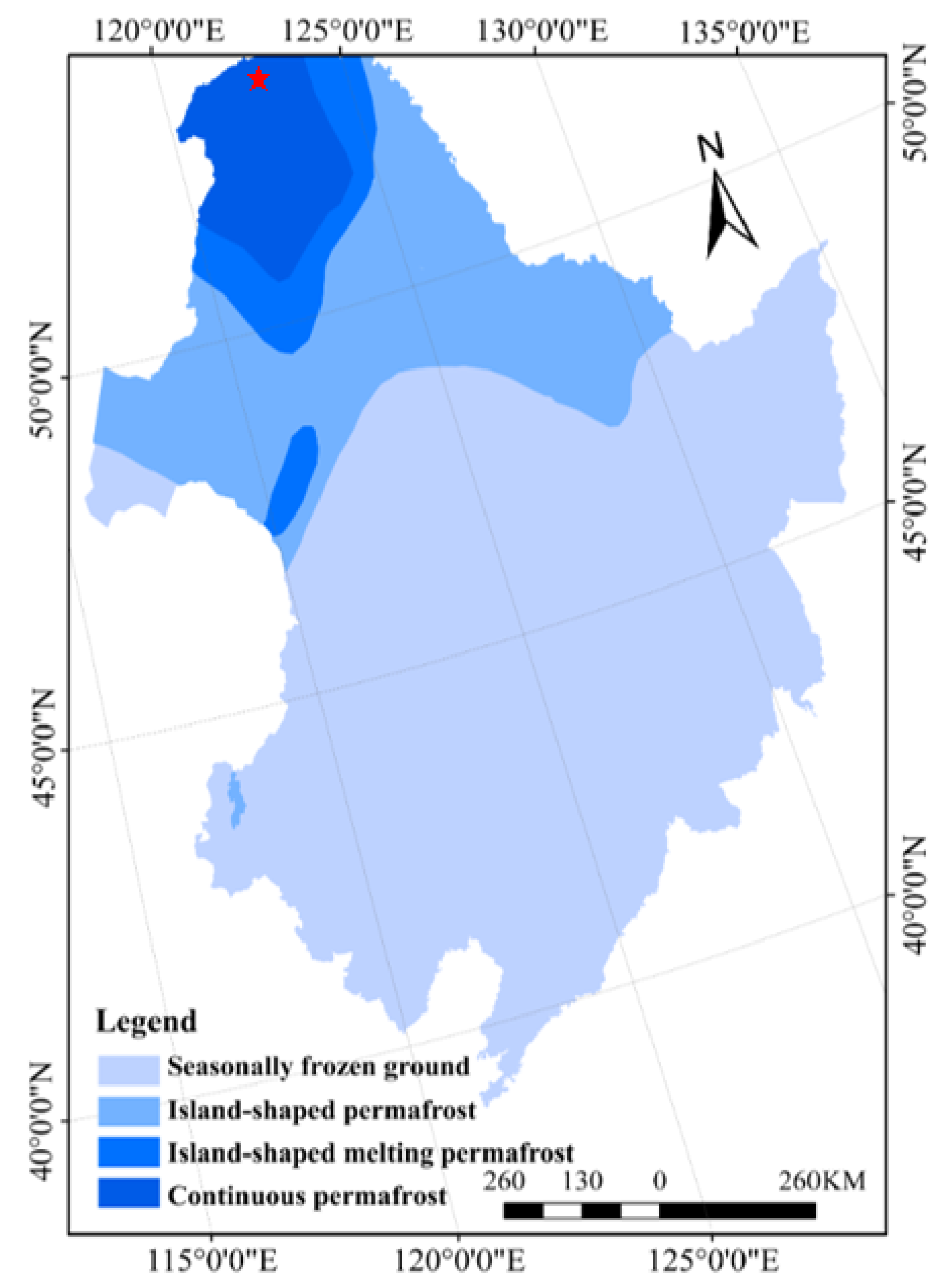

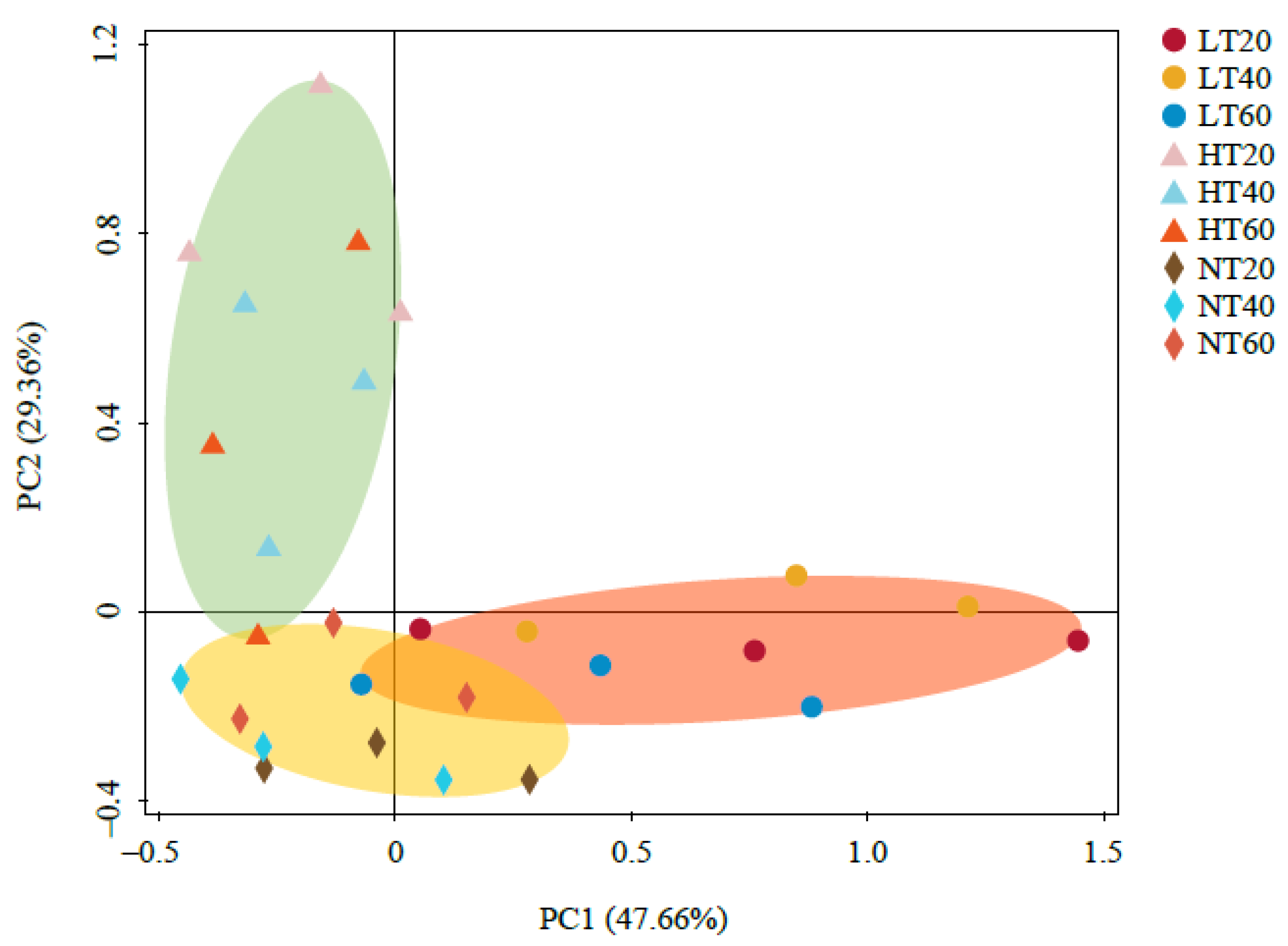
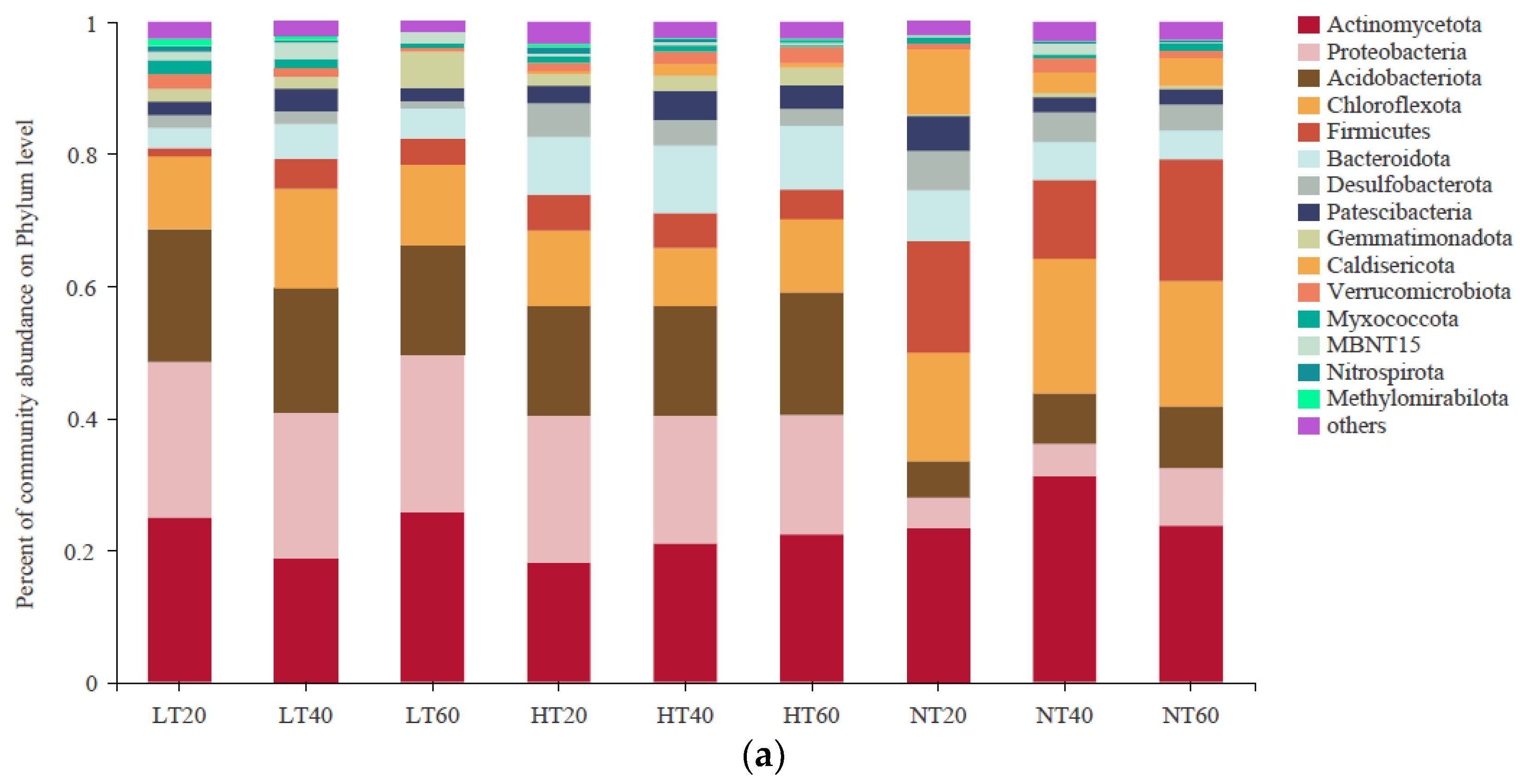

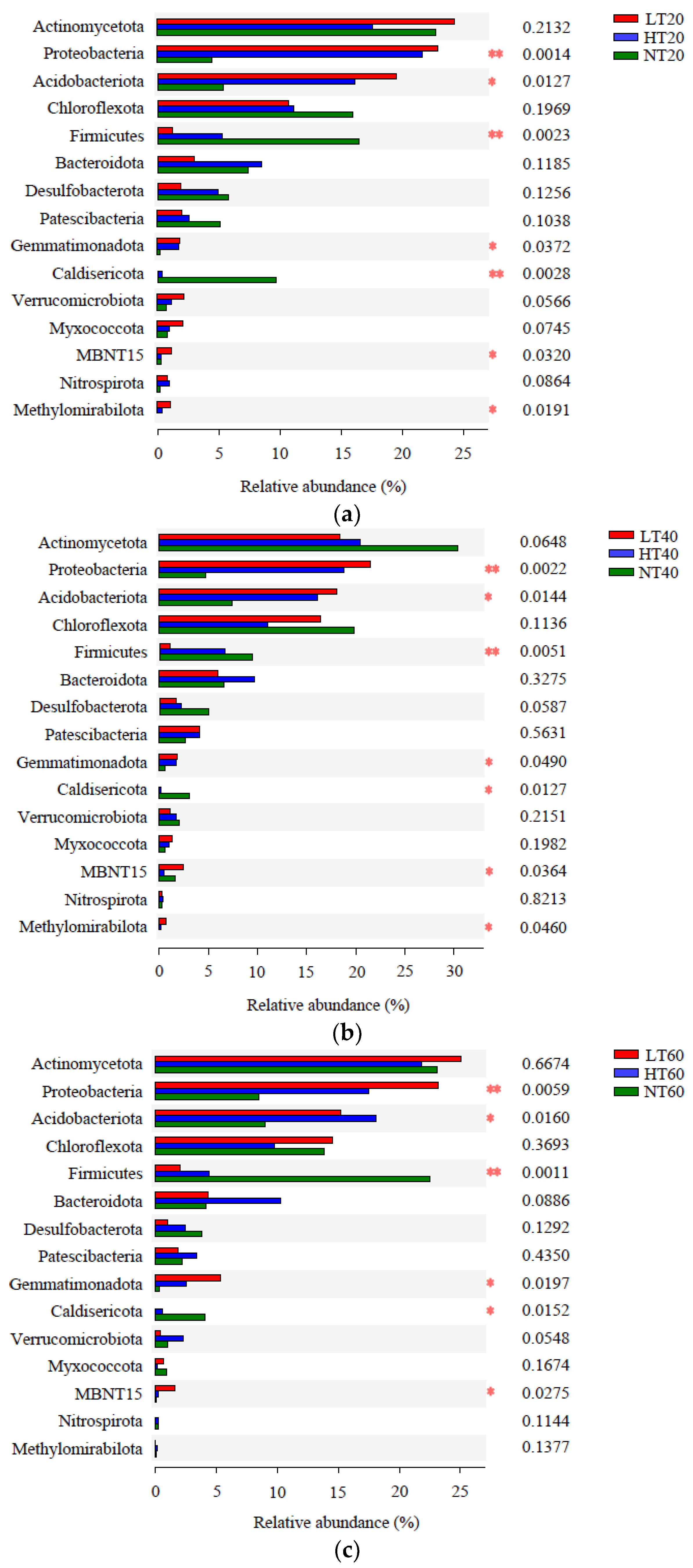
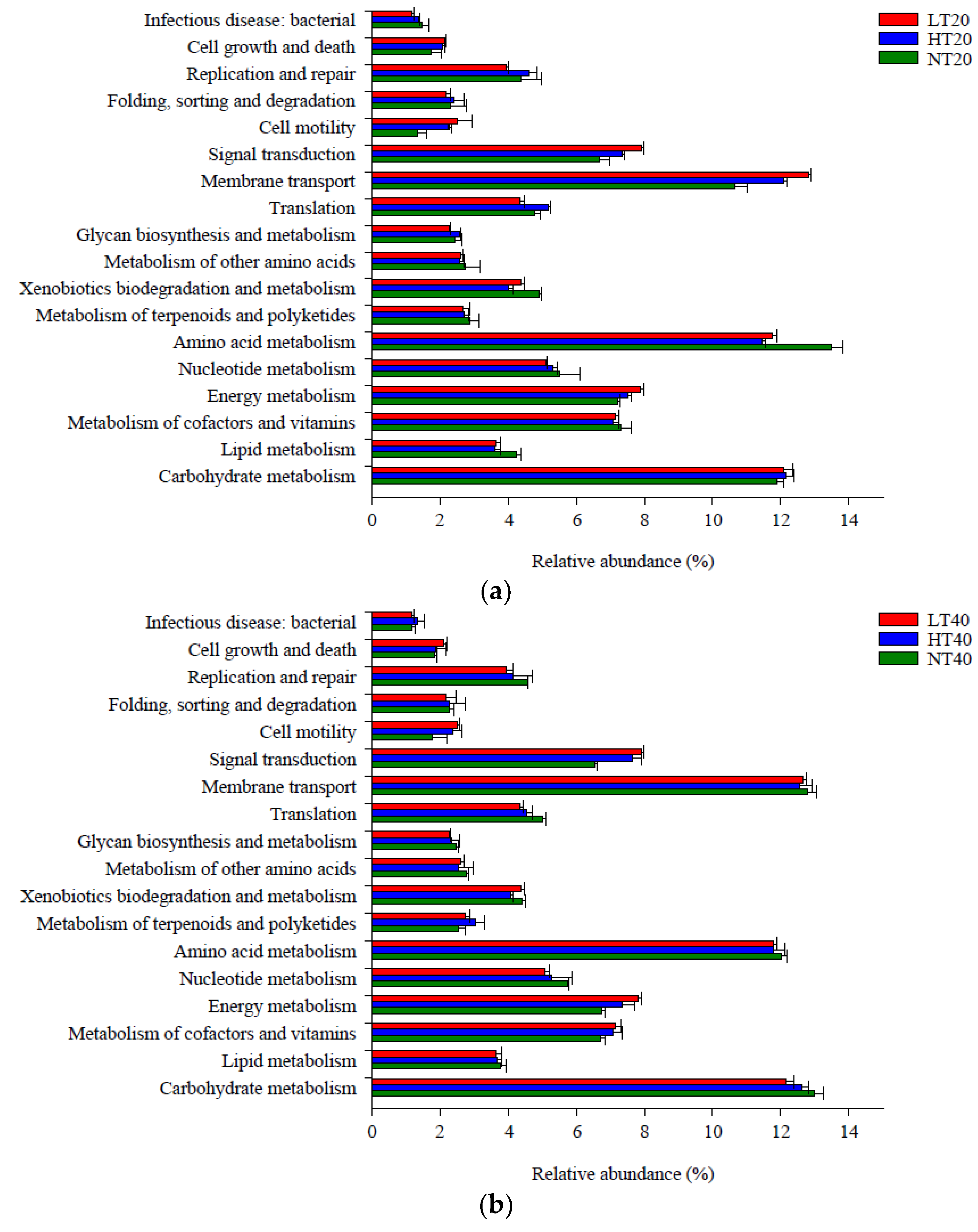
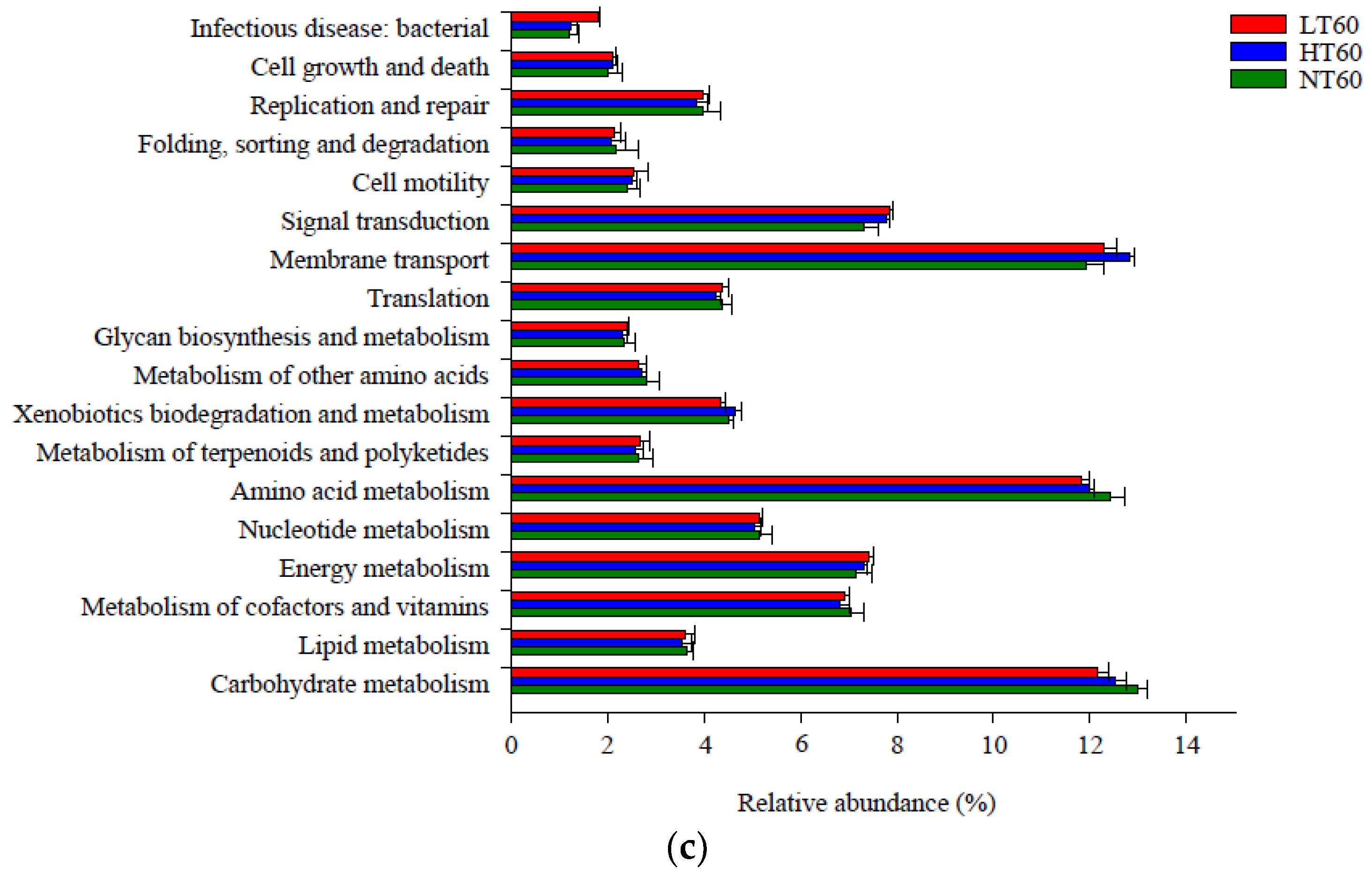
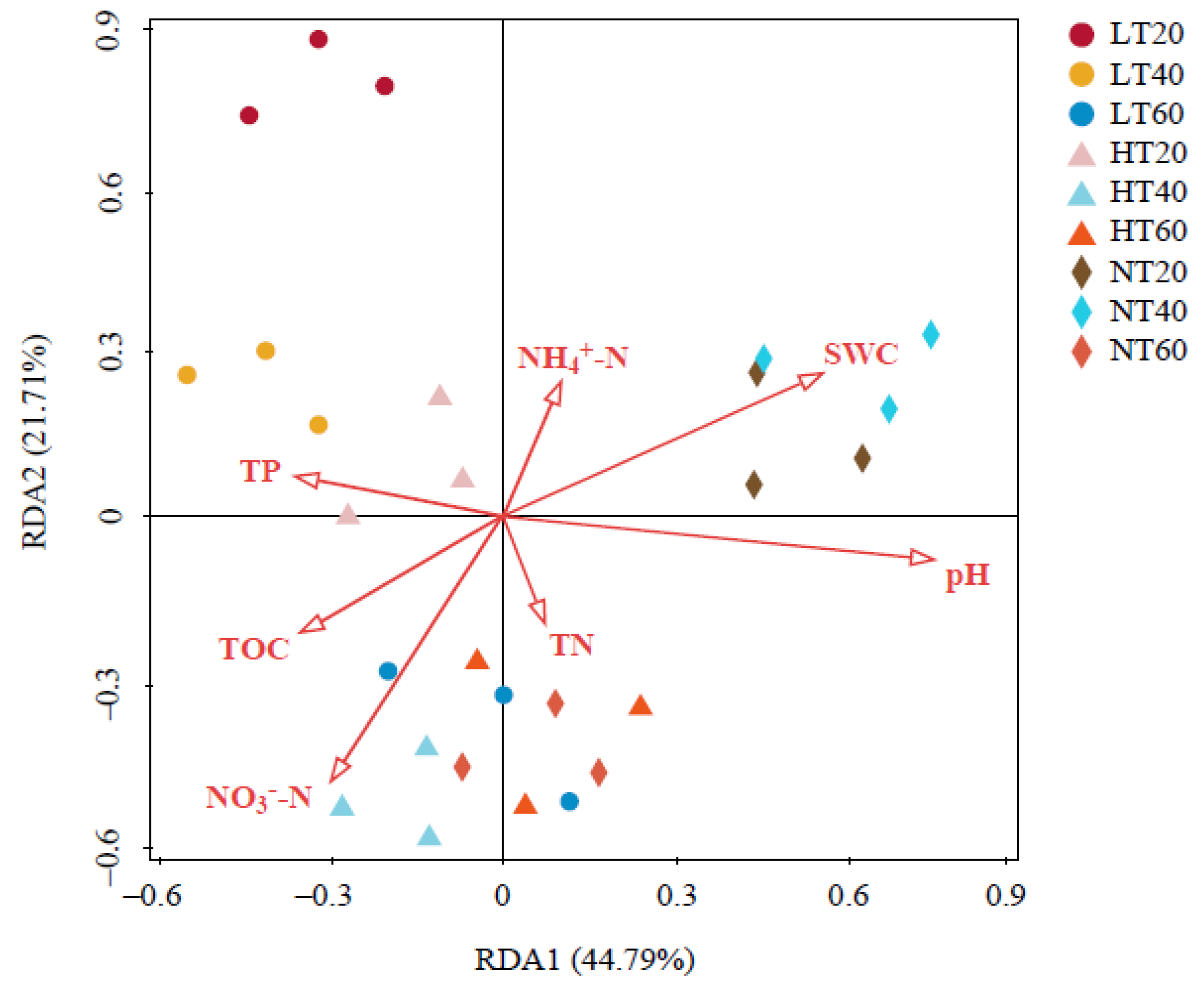
| Sample | pH | TOC (g/kg) | TN (g/kg) | TP (g/kg) | NH4+-N (mg/kg) | NO3–-N (mg/kg) | SWC (%) |
|---|---|---|---|---|---|---|---|
| LT20 | 4.89 ± 0.07 Ba | 287.39 ± 25.12 Ca | 11.35 ± 1.62 Ba | 2.09 ± 0.05 Ba | 80.12 ± 2.28 Aa | 3.67 ± 0.46 Ba | 56.86 ± 8.33 Ba |
| LT40 | 4.73 ± 0.11 Ba | 193.42 ± 9.89 Bb | 13.08 ± 1.16 Ba | 1.65 ± 0.06 Cb | 65.71 ± 0.96 Ab | 3.35 ± 0.73 Bb | 47.98 ± 5.47 Bab |
| LT60 | 4.81 ± 0.02 Ba | 108.26 ± 12.95 Bc | 5.63 ± 2.64 Ab | 1.07 ± 0.09 Bc | 36.53 ± 3.41 Ac | 1.74 ± 0.18 Bb | 40.77 ± 2.84 Bb |
| HT20 | 4.93 ± 0.06 Bab | 362.66 ± 18.61 Ba | 19.93 ± 3.31 Aa | 2.23 ± 0.07 Bb | 66.09 ± 3.49 Ba | 4.65 ± 0.52 ABa | 72.81 ± 7.19 ABa |
| HT40 | 4.85 ± 0.04 Bb | 305.80 ± 22.72 Ab | 20.21 ± 0.94 Aa | 2.51 ± 0.11 Ba | 72.25 ± 4.81 Aa | 3.13 ± 0.34 Bb | 61.26 ± 3.72 Aa |
| HT60 | 5.04 ± 0.10 Aa | 139.75 ± 16.59 Bc | 7.36 ± 2.10 Ab | 1.38 ± 0.04 Ac | 42.64 ± 1.25 Ab | 2.08 ± 0.23 ABc | 44.57 ± 2.64 ABb |
| NT20 | 5.09 ± 0.05 Aa | 436.11 ± 20.49 Aa | 20.32 ± 2.17 Aa | 3.67 ± 0.14 Aa | 56.28 ± 4.46 Cb | 5.96 ± 1.05 Aa | 83.32 ± 6.87 Aa |
| NT40 | 5.16 ± 0.07 Aa | 341.03 ± 14.67 Ab | 13.78 ± 0.79 Bb | 2.95 ± 0.11 Ab | 73.13 ± 2.11 Aa | 4.82 ± 0.61 Aa | 70.13 ± 4.49 Aa |
| NT60 | 5.13 ± 0.04 Aa | 187.96 ± 8.46 Ac | 8.57 ± 1.08 Ac | 1.20 ± 0.08 ABc | 39.55 ± 5.86 Ac | 2.33 ± 0.26 Ab | 53.09 ± 5.26 Ab |
| Sample | Shannon | Simpson | ACE | Chao1 |
|---|---|---|---|---|
| LT20 | 5.97 ± 0.10 Aa | 0.007 ± 0.002 Bb | 2165.95 ± 85.70 Aa | 2186.35 ± 97.49 Aa |
| LT40 | 5.59 ± 0.13 Ab | 0.010 ± 0.002 Cb | 1802.12 ± 61.45 Ab | 1810.19 ± 58.44 Ab |
| LT60 | 4.79 ± 0.06 Bc | 0.022 ± 0.004 Aa | 1405.42 ± 50.32 Bc | 1410.09 ± 46.74 Bc |
| HT20 | 5.68 ± 0.07 Ba | 0.009 ± 0.001 Bb | 1992.04 ± 136.63 Aa | 1954.07 ± 154.49 Aa |
| HT40 | 5.27 ± 0.05 Bb | 0.015 ± 0.002 Bab | 1623.62 ± 65.26 Ab | 1614.00 ± 70.91 Ab |
| HT60 | 5.01 ± 0.09 Bc | 0.016 ± 0.004 ABa | 1207.23 ± 32.78 Cc | 1222.37 ± 39.27 Cc |
| NT20 | 4.74 ± 0.07 Cb | 0.023 ± 0.002 Aa | 998.83 ± 85.65 Bb | 996.25 ± 92.63 Bb |
| NT40 | 4.75 ± 0.04 Cb | 0.020 ± 0.001 Aa | 831.97 ± 111.81 Bb | 823.53 ± 120.95 Bb |
| NT60 | 5.43 ± 0.11 Aa | 0.012 ± 0.001 Bb | 1765.31 ± 73.66 Aa | 1737.08 ± 62.44 Aa |
Publisher’s Note: MDPI stays neutral with regard to jurisdictional claims in published maps and institutional affiliations. |
© 2022 by the authors. Licensee MDPI, Basel, Switzerland. This article is an open access article distributed under the terms and conditions of the Creative Commons Attribution (CC BY) license (https://creativecommons.org/licenses/by/4.0/).
Share and Cite
Liu, L.; Wang, Z.; Ma, D.; Zhang, M.; Fu, L. Diversity and Distribution Characteristics of Soil Microbes across Forest–Peatland Ecotones in the Permafrost Regions. Int. J. Environ. Res. Public Health 2022, 19, 14782. https://doi.org/10.3390/ijerph192214782
Liu L, Wang Z, Ma D, Zhang M, Fu L. Diversity and Distribution Characteristics of Soil Microbes across Forest–Peatland Ecotones in the Permafrost Regions. International Journal of Environmental Research and Public Health. 2022; 19(22):14782. https://doi.org/10.3390/ijerph192214782
Chicago/Turabian StyleLiu, Lin, Zhongliang Wang, Dalong Ma, Man Zhang, and Lingyu Fu. 2022. "Diversity and Distribution Characteristics of Soil Microbes across Forest–Peatland Ecotones in the Permafrost Regions" International Journal of Environmental Research and Public Health 19, no. 22: 14782. https://doi.org/10.3390/ijerph192214782




